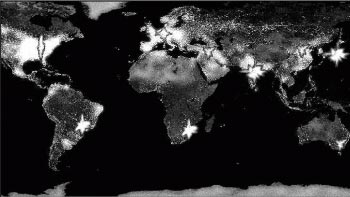
Main Menu
|
Museum of Media History - 2014 - What is
EPIC? In the year 2014 people have access to a breadth and depth of information unimaginable in an earlier age. Everyone contributes in some way.
Everyone participates to create a
living, breathing mediascape. However, the Press, as you know it, has ceased to
exist.
The Fourth Estate’s fortunes have waned. 20th Century news organizations are
an after-thought, a lonely remnant of a not too distant past. In 1989, Tim Berners-Lee, a computer scientist at the CERN particle physics laboratory in Switzerland, invents the World Wide Web. 1994 sees the founding of Amazon.com. Its young creator dreams of a store that sells everything. Amazon’s model, which would come to set the standard for Internet sales, is built on automated personalized recommendations – a store that can make suggestions. In 1998, two Stanford programmers create Google. Their algorithm echoes the language of Amazon, it treats links as recommendations, and from that foundation powers the world’s most effective search engine. In 1999, TiVo transforms television by unshackling it from the constraints of time - and commercials. Almost no one who tries it ever goes back. That year, a dot-com start-up named Pyra Labs unveils Blogger, a personal publishing tool. Friendster launches in 2002 and hundreds of thousands of young people rush to populate it with an incredibly detailed map of their lives, their interests and their social networks. Also in 2002, Google launches GoogleNews, a news portal. News organizations cry foul. GoogleNews is edited entirely by computers. In 2003, Google buys Blogger. Google’s plans are a mystery, but their interest in Blogger is not unreasonable. 2003 is the Year of the Blog. 2004 would be remembered as the year that everything began. Reason Magazine sends subscribers an issue with a satellite photo of their houses on the cover and information custom-tailored to each subscriber inside. Sony and Philips unveil the world’s first mass-produced electronic paper. Google unveils GMail, with a gigabyte of free space for every user. Microsoft unveils Newsbot, a social news filter. Amazon unveils A9, a search engine built on Google’s technology that also incorporates Amazon’s trademark recommendations. And then, Google goes public. Awash in new capital, the company makes a major acquisition. Google buys TiVo. 2005 – In response to Google’s recent moves, Microsoft buys Friendster. 2006 – Google combines all of its services - TiVo, Blogger, GMail, GoogleNews and all of its searches into the Google Grid, a universal platform that provides a functionally limitless amount of storage space and bandwidth to store and share media of all kinds. Always online, accessible from anywhere. Each user selects her own level of privacy. She can store her content securely on the Google Grid, or publish it for all to see. It has never been easier for anyone, everyone to create as well as consume media. 2007 – Microsoft responds to Google’s mounting challenge with Newsbotster, a social news network and participatory journalism platform. Newsbotster ranks and sorts news, based on what each user’s friends and colleagues are reading and viewing and it allows everyone to comment on what they see. Sony’s ePaper is cheaper than real paper this year. It’s the medium of choice for Newsbotster. 2008 sees the alliance that will challenge Microsoft’s ambitions. Google and Amazon join forces to form Googlezon. Google supplies the Google Grid and unparalled search technology. Amazon supplies the social recommendation engine and its huge commercial infrastructure. Together, they use their detailed knowledge of every user’s social network, demographics, consumption habits and interests to provide total customization of content - and advertising. The News Wars of 2010 are notable for the fact that no actual news organizations take part. Googlezon finally checkmates Microsoft with features the software giant cannot match. Using a new algorithm, Googlezon’s computers construct news stories dynamically, stripping sentences and facts from all content sources and recombining them. The computer writes a news story for every user. In 2011, the slumbering Fourth Estate awakes to make its first and final stand. The New York Times Company sues Googlezon, claiming that the company’s fact-stripping robots are a violation of copyright law. The case goes all the way to the Supreme Court, which on August 4, 2011 decides in favour of Googlezon. On Sunday, March 9 2014, Googlezon unleashes EPIC. Welcome to our world. The ‘Evolving Personalized Information Construct’ is the system by which our sprawling, chaotic mediascape is filtered, ordered and delivered. Everyone contributes now – from blog entries, to phone-cam images, to video reports, to full investigations. Many people get paid too – a tiny cut of Googlezon’s immense advertising revenue, proportional to the popularity of their contributions. EPIC produces a custom contents package for each user, using his choices, his consumption habits, his interests, his demographics, his social network – to shape the product. A new generation of freelance editors has sprung up, people who sell their ability to connect, filter and prioritize the contents of EPIC. We all subscribe to many Editors; EPIC allows us to mix and match their choices however we like. At its best, edited for the savviest readers, EPIC is a summary of the world – deeper, broader and more nuanced than anything ever available before. Transcribed by Robin Sloan
|
|
||
